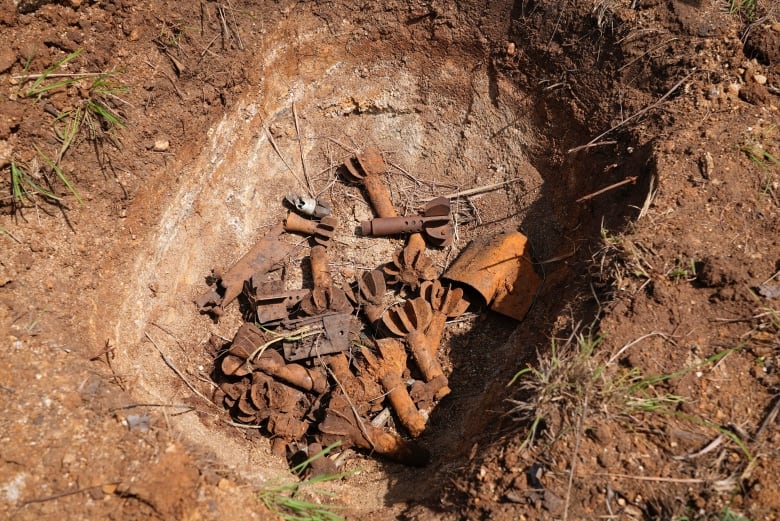
The United States has decided to send cluster munitions to Ukraine to help its military push back Russian forces entrenched along the front lines.
The Biden administration is expected to announce on Friday that it will send thousands of them as part of a new military aid package worth $800 million US, according to people familiar with the decision who were not authorized to discuss it publicly before the official announcement and spoke on condition of anonymity.
But the move will likely trigger outrage among humanitarian groups and criticism from NATO and European Union allies of Ukraine long opposed to the use of cluster bombs.
Here is a closer look at the issue.
What is a cluster munition?
A cluster munition is a bomb that opens in the air and releases smaller “bomblets” across a wide area. The bomblets are designed to take out tanks and equipment, as well as troops, hitting multiple targets at the same time.
The munitions are launched by the same artillery weapons that the U.S. and allies have already provided to Ukraine for the war — such as howitzers — and the type of cluster munition that the U.S. is planning to send is based on a common 155 mm shell that is already widely in use across the battlefield.
What’s the ‘dud rate’ and why is it important?
The dud rate refers to the percentage of unexploded rounds. In previous conflicts, cluster munitions have had a high dud rate, which meant that thousands of the unexploded bomblets remained behind and killed and maimed civilians. That’s happened recently in conflicts in Syria and Yemen, but the grisly impact can be felt decades later, as seen in parts of Southeast Asia, where people are still killed by explosives from the Vietnam War.

A 2009 U.S. law bans exports of cluster munitions with bomblet failure rates higher than one per cent, but a U.S. president can waive the prohibition.
Brig. Gen. Pat Ryder at the Pentagon said Thursday “the ones that we are considering providing would not include older variants with [unexploding] rates that are higher than 2.35 per cent.”
What has Canada said and done on the subject?
Canada has considered itself a leader in the international movement to limit the damage that weapons like landmines and cluster munitions can cause to war-torn communities.
The Canadian government helped spearhead a movement that led more than 100 countries to sign the Ottawa Treaty in December 1997, and dozens more joined in the years after.

Canada is also among the more than two-thirds of NATO countries who are signatories to a 2010 convention on cluster munitions banning their use, production or stockpiling.
Within days of the Ukraine war getting underway in February 2022, Canada’s mission to the United Nations in Geneva expressed concern with allegations that Russia was using cluster munitions, resulting in civilian casualties.
As well, Canada has long touted its efforts to demine and sweep countries of unexploded ordnances, including an initiative announced just months ago to support projects in Cambodia and Laos.
Why use them now?
The aforementioned convention banning the use of cluster bombs has been joined by more than 120 countries, which agreed not to use, produce, transfer or stockpile the weapons and to clear them after they’ve been used. But that list of countries does not include Russia, Ukraine or the U.S.
Ammunition supply is the biggest reason. For more than a year, the U.S. has dipped into its own stocks of traditional 155 mm howitzer munitions and sent more than two million rounds to Ukraine. Allies across the globe have provided hundreds of thousands more.
Yehor Cherniev, a member of Ukraine’s parliament, told reporters at a German Marshall Fund event in the U.S. this spring that Kyiv would likely need to fire 7,000 to 9,000 of the rounds daily in intensified counteroffensive fighting, putting substantial pressure on U.S. and allied stocks.
The U.S. hasn’t used them in conflict since early this century in Iraq, it says, and has large amounts of them in storage. A March 2023 letter from congressional Republicans to the Biden administration said the U.S. may have as many as three million cluster munitions available for use.
What’s happening in Ukraine?
Army Gen. Mark Milley, chairman of the Joint Chiefs of Staff, said last week that Russian troops are using them on the battlefield in Ukraine and that Ukrainian forces have received cluster bombs from other allies and have deployed the arms.
During the early days of the war, there were repeated instances of Russian cluster bombs cited by Human Rights Watch, including when they hit near a preschool in the northeastern city of Okhtyrka. The open-source intelligence group Bellingcat said its researchers found cluster munitions in that strike as well as multiple cluster attacks in Kharkiv, Ukraine’s second-largest city, which is also in the northeast.
Cluster munitions used by Russia & Ukraine have killed and injured civilians, and they will continue to harm residents for years to come. <br><br>The US should not contribute to these risks by transferring more cluster munitions to Ukraine. <br><br>New from <a href=”https://twitter.com/hrw?ref_src=twsrc%5Etfw”>@hrw</a>: <a href=”https://t.co/biOFAS8toy”>https://t.co/biOFAS8toy</a> <a href=”https://t.co/0ijrOHV5jI”>pic.twitter.com/0ijrOHV5jI</a>
—@ida_sawyer
More recently, in March, police in the Ukrainian-held city of Kostiantynivka told AP journalists that a Russian attack in the town included the use of cluster munitions.
On Thursday, Human Rights Watch released a new report documenting their potential use so far, including an incident in 2022 in Izium in which a Ukrainian cluster munitions rocket killed at least eight civilians and wounded 15 more.
Is using them a war crime?
Use of cluster bombs itself does not violate international law, but using them against civilians can be a violation. As in any strike, determining a war crime requires looking at whether the target was legitimate and if precautions were taken to avoid civilian casualties.
“The part of international law where this starts playing [a role], though, is indiscriminate attacks targeting civilians,” Human Rights Watch’s associate arms director Mark Hiznay told The Associated Press. “So that’s not necessarily related to the weapons, but the way the weapons are used.”
In an interview with Reuters in the spring, Republican Sen. Lindsey Graham of South Carolina expressed confidence in their use.
“This is a war where [the Ukrainians] are outmanned,” Graham told Reuters. “And cluster munitions really are pretty lethal to mass formations as well as armour. In the areas where they are going to use this stuff, there are no civilians.”
Others in Congress are not as sanguine. Democratic House members Ilhan Omar of Minnesota and Sara Jacobs of California have introduced an amendment to the National Defence Authorization seeking to ban the transfer of cluster munitions.